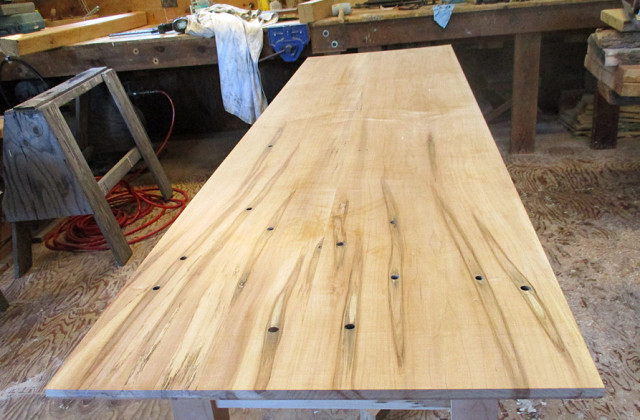Stories in a Maple Board
By Hans M. Carlson
I’m thinking about the beauty of wood this morning—about the revelation that comes when a seasoned board comes out of the planer and shows itself truly for the first time. This is the moment when wood gives advice. When it hints at what shape it would like to take, as cabinet or table, or some other useful and beautiful thing. In woodworking, you often impose the needs of the project on the materials, but the most satisfying moments come when you listen; when you work with the wood, and show thankfulness for what the tree has given to the work at hand. This is thankfulness for the woodlands that supply our constant human need as well.
I’m building a table with a friend this week, for a benefit auction later in the summer. We’re using maple boards that were cut half a mile from the shop where we are working, a sugar maple that was tapped for years by my friend and earlier sugar makers. Then the town cut down the tree for safety reasons, and the log made its way to my friend’s mill. When he cut it open, the old tap holes were clearly visible in the butt log, and it became obvious that these boards had a story to tell. This table has become our way of giving the tree the chance to do that, and to keep alive in memory something that has passed out of the world.
The table will be a record of decades of harvesting sap, and will show some of the conditions under which that was done. Trees are generally tapped a few feet off the ground, so most of the holes are clustered toward the bottom of the boards. There are a couple of holes higher up, however, marking those years when the snow must have been particularly deep here in Norfolk. Deep snows are less usual than they once were, but the boards will keep some of that in memory.
The table is also the record of how the tree reacted to all those years of human use. Each tap hole has a long dark streak that runs up and down the grain for seven or eight inches, and this is a remnant of the tree’s natural defenses at work. The streaks are the aftereffect of ambrosia fungus getting in through the tap hole, causing the tree to alter its chemical makeup to fight the fungus. Years of this left its marks on the wood, an annual cycle of healing for each harvest that put syrup on other tables.
We wound maple trees when we tap them to make syrup. It’s worth remembering that. They have to heal afterward, and like so much wounding and healing in life, it doesn’t show much from the outside. These boards are a record of that process, but they are also a record of the fact that the tapping was done well, because the streaks are isolated and regular. Trees are compartmental organisms and can wall off areas, altering some cell structure without affecting sap flow or overall health. If the tapping hadn’t been done well, the fungus would have won the battle, and the tree would not have lived to the old age it did.
Care in its use meant that this tree lived long enough for other fungi to find their way in through natural wounds. These have left areas of semi-rotted wood in our boards, something that woodworkers call spalting. Spalted wood is sound enough to be used, but has fungal patterns and staining reminiscent of some aged cheeses. That too is a record of interplay of tree and the world outside—of intertwined life cycles in the natural world.
All these scars are beautiful to me, and the tap holes most of all. I love figured wood because it speaks of character and individuality. The tap holes in these boards, however, also speak to me of community and history. We know whose sugarbush the tree came from, and so we know the cast of characters who might have drilled these particular holes. The table has already elicited stories about the past here in Norfolk, and about many people who are no longer around. Maybe this will continue when this table finds a home after the auction, a record not only of the tree as a part of nature but also of the community that relied on it.
Photo by Hans M. Carlson: The holes and the beautiful patterns in the maple wood of this table are a record of the tree’s history.


A very thoughtful, educational, and well written piece. I too appreciate the beauty of the wood I mill from the down trees I find in Missouri and Kansas. While the hard maples are scarce, I’ve found satisfaction in the walnut, hedge, black locust, and soft maples of the area. Your statement “When it hints at what shape it would like to take “applies to my addiction to turning bowls also. I never know exactly what shape is hidden in a blank until all of the shavings drop away and it reveals itself. Very rewarding and I can barely wait to begin the next one. Thanks and happy woodworking.